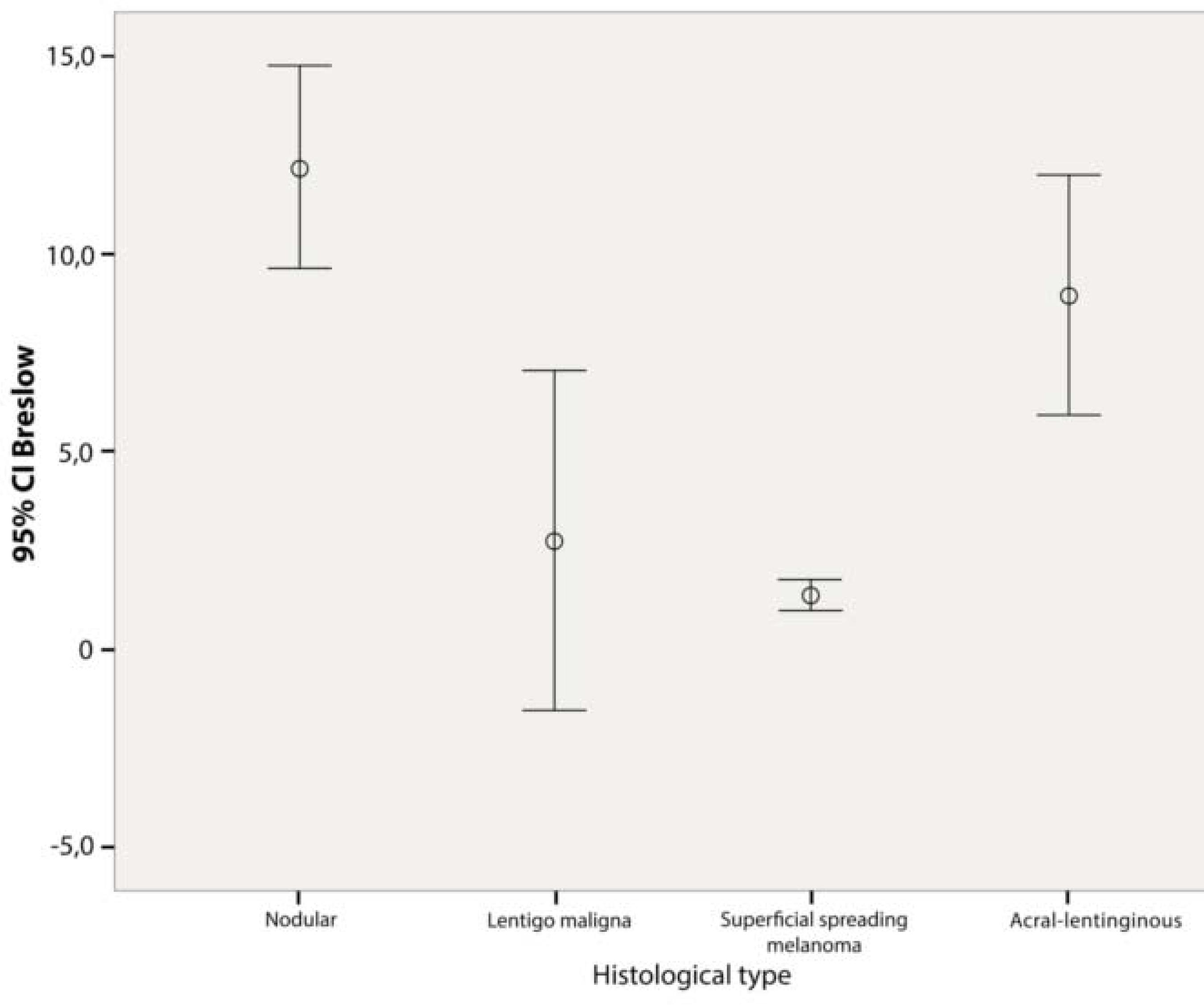| São Paulo-SP |
Criado et al.77. Criado PR, Vasconcellos C, Sittart JAS, Valente NYS, Moura BPS, Barbosa GL, et al. Melanoma malign cutâneo primário: estudo retrospectivo de 1963 a 1997 no Hospital do Servidor Público Estadual de São Paulo. Rev Ass Med Bras. 1999;45:157-62.
|
222 |
1963-1997 |
- |
- |
39.8% |
10.2% |
28.4%
|
9.7% |
| Blumenau-SC |
Naser88. Nasser N. Cutaneous melanoma - a 30-year-long epidemiological study conducted in a city in southern Brazil from 1980-2009. An Bras Dermatol. 2011;86:932-41.
|
1002 |
1980-2009 |
51.6% |
37.0% |
23.2% |
22.8% |
58.7% |
10.5% |
| São Paulo-SP |
Lapa et al.99. Lapa MS, Guedes KF, Schalch FO, Landman G. Cutaneous malignant melanomas treated at the Hospital do Cancer in São Paulo: Retrospective study for the evaluation of distribution, prognostic factors and survival. An Bras Dermatol. 2002;77:313-20.
|
115 |
1985-1987 |
- |
19.8% |
- |
- |
9.6%
|
- |
| Porto Alegre-RS |
Venegas et al.1010. Venegas LFP, Flores C, Blacher GG, Daudt AW, Cerski CTS. Melanoma maligno cutâneo no Rio Grande do Sul: estudo de 101 casos. Rev Ass Med Brasil. 1992;38:122-6.
|
101 |
1985-1989 |
- |
36.6% |
- |
35.6% |
- |
- |
| Londrina-PR |
Gon et al.1111. Gon AS, Minelli L, Guembarovski AL. Primary cutaneous melanoma in Londrina. An Bras Dermatol. 2001;76:413-26.
|
303 |
1990-1999 |
37.1% |
41.1% |
23.1% |
34.8% |
13.4%
|
12.9% |
| Porto Alegre-RS |
Bakos1212. Bakos L. Melanomas malignos e etnia. An Bras Dermatol. 1991;66:299-302.
|
153 |
- |
51.6% |
- |
- |
- |
- |
- |
| Rio de Janeiro-RJ |
Fernandes et al.1313. Fernandes NC, Calmon R, Maceira JP, Cuzzi T, Silva CSC. Cutaneous melanoma: prospective study of 65 cases. An Bras Dermatol. 2005;80:25-34.
|
65 |
1993-2003 |
63.0% |
12.3% |
- |
- |
- |
- |
| São Paulo-SP |
Ferrari Júnior et al.33. Ferrari Júnior NM, Muller H, Ribeiro M, Maia M, Sanches Júnior JA. Cutaneous melanoma: descriptive epidemiological study. São Paulo Med J. 2008;126:41-7.
|
364 |
1993-2006 |
33.8% |
26.1% |
25.4% |
20.4% |
23.9% |
15.7% |
| Brasília-DF |
Pinheiro et al.1414. Pinheiro AMC, Friedman H, Cabral ALSV, Rodrigues HA. Cutaneous melanoma: clinical, epidemiological and histopathological characteristics at the University Hospital of Brasília between January 1994 and April 1999. An Bras Dermatol. 2003;78:179-86.
|
32 |
1994-1999 |
10.0% |
45.0% |
19.4% |
32.3% |
42.3%
|
12.9% |
| Porto Alegre-RS |
Bakos et al.1515. Bakos L, Wagner M, Bakos RM, Leite CS, Sperhacke CL, Dzekaniak KS, et al. Sunburn, sunscreens and phenotypes: some risk factors for cutaneous melanoma in southern Brazil. Int J Dermatol. 2002;41:557-62.
|
103 |
1995-1998 |
61.2% |
23.3% |
- |
- |
- |
- |
| Passo Fundo-RS |
Borges et al.1616. Borges SZ, Bakos L, Cartell A, Wagner M, Agostini A, Lersch E. Distribution of clinicalpathological types of cutaneous melanomas and mortality rate in the region of Passo Fundo, RS, Brazil. Int J Dermatol. 2007;46:679-86.
|
229 |
1995-2001 |
61.6% |
25.3% |
24.4% |
7.9% |
47.2% |
7.9% |
| Porto Alegre-RS |
Ponzio et al.1717. Ponzio HA. Frequência de melanoma maligno no Serviço de Dermatologia da I SCMPA/UFRGS. An Bras Dermatol. 1998;73:S6-11.
|
167 |
- |
35.3% |
- |
- |
- |
- |
- |
| Florianópolis-SC |
Weber et al.11. Weber AL, Nunes DH, Souza Filho JJ, Pinto CJC. Assessment of 496 pathological reports of melanoma diagnosed in the city of Florianopolis, SC, Brazil. An Bras Dermatol. 2007;82:227-32.
|
496 |
1999-2004 |
60.0% |
30.0% |
- |
- |
45.7% |
37.5% |
| Porto Alegre-RS |
Bonfá et al.44. Bonfá R, Bonfá R, Furian RD, Bonamigo RR, Duro KM, Zelmanowicz AM. Early diagnosis of cutaneous melanoma: an observation in southern Brazil. An Bras Dermatol. 2011;86:215-21.
|
328 |
2000-2005 |
62.8% |
14.6% |
27.4% |
7.0% |
36.9% |
26.2% |
| São Paulo-SP |
Maia et al.1818. Maia M, Russo C, Ferrari N, Ribeiro MCS de A, Santos ABOS. Reflections regarding The epidemiology of cutaneous melanoma in Brazil. An Bras Dermatol. 2002;77:163-70.
|
190 |
- |
41.1% |
- |
- |
- |
- |
- |
| Florianópolis-SC |
Dimatos et al.55. Dimatos DC, Duarte FO, Machado RS, Vieira VJ, Vasconcellos ZAA, Bins-Ely J, et al. Melanoma cutâneo Brasil. Arq Cat Med. 2009;38(Supl. 1):14-9.
|
105 |
2003-2007 |
68.7% |
18.2% |
19.0% |
5.7% |
30.4% |
39.0% |
| Criciúma-SC |
Konrad el al.1919. Konrad P, Fabris MR, Melao S, Blanco LFO. Histopathological and epidemiological profile of cases of primary cutaneous melanoma diagnosed in Criciúma-SC between 2005 and 2007. An Bras Dermatol. 2011;86:457-61.
|
72 |
2005-2007 |
50.0% |
23.4% |
26.1% |
0.0% |
25.0%
|
29.6% |
| Teresina-PI |
This study |
313 |
2000-2010 |
18.6% |
52.8% |
32.7% |
26.1% |
19.6% |
7.9% |


